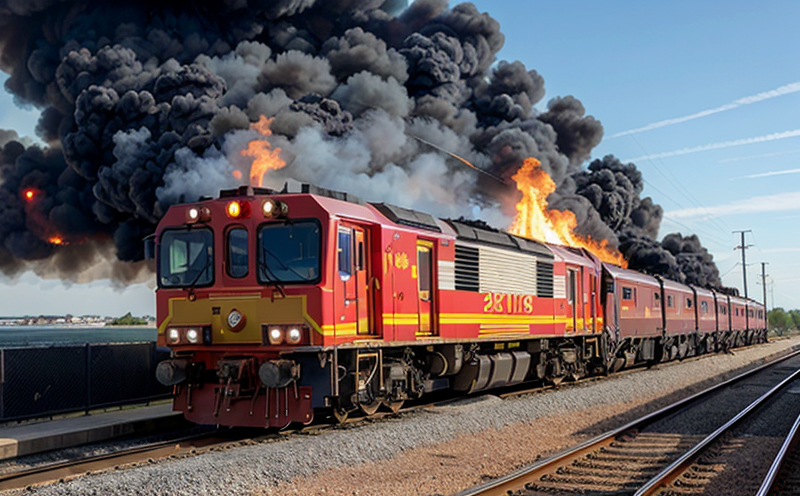Toxicity Assessment of Smoke from Transport Materials
Understanding and mitigating the toxicity of smoke produced by transport materials is crucial in ensuring fire safety. This service assesses the chemical composition, physical properties, and potential health impacts of the smoke generated during the combustion of various transportation-related materials used in railways and marine environments.
The importance of this testing cannot be overstated, especially given the stringent regulations governing rail and marine transport industries. Compliance with international standards such as ISO 13952-1, ISO 16780, and ASTM E662 is critical for ensuring that materials used in these sectors are not only safe but also meet regulatory requirements.
The test typically involves the combustion of various transport-related materials under controlled conditions. Specimens include items such as insulation, upholstery, and other components commonly found in railway carriages or marine vessels. By subjecting these materials to a standard fire environment, we can accurately measure the emissions of harmful gases like carbon monoxide (CO), nitrogen oxides (NOx), formaldehyde, and particulate matter.
The data collected during this process is then analyzed using advanced analytical instruments such as gas chromatography-mass spectrometry (GC-MS) to identify specific compounds present in the smoke. This information helps determine whether the materials meet the specified toxicity thresholds set by international standards. The results of these tests are essential for manufacturers and designers to make informed decisions about material selection, ensuring that any potential risks to passengers or crew members are minimized.
Moreover, this testing plays a vital role in improving fire safety protocols within the industry. By identifying problematic materials early on through rigorous evaluation, stakeholders can implement corrective measures before they enter large-scale production cycles. This proactive approach not only enhances overall safety standards but also reduces liability risks associated with substandard products.
In summary, this service provides valuable insights into how different transport-related materials behave under fire conditions and what types of pollutants might be released into the atmosphere. It serves as a critical tool for maintaining high levels of occupational health and safety across various sectors while contributing positively to environmental protection efforts.
Why It Matters
The safety and well-being of passengers, crew members, and the general public are paramount considerations when it comes to transportation systems. The combustion process inherent in many transport materials can lead to the release of toxic substances into enclosed spaces such as railway carriages or marine vessels. These emissions pose significant risks if not properly managed.
For instance, carbon monoxide (CO) is one of the most dangerous pollutants produced during fires involving certain types of insulation or upholstery used in transport vehicles. Even at relatively low concentrations, CO can cause severe health issues including headaches, dizziness, and even death in extreme cases. Formaldehyde, another common byproduct from some materials, has been linked to respiratory problems and other adverse effects on human health.
Given the confined nature of railway compartments and passenger cabins aboard ships, it is essential that any smoke generated during a fire contains minimal amounts of these hazardous components. Failure to comply with established safety standards could result in severe consequences for both personnel involved directly in operations as well as those indirectly affected by poor air quality.
- Reduces Health Risks: Ensures that materials used do not contribute to harmful levels of smoke during a fire event.
- Enhances Safety Protocols: Provides critical data needed for developing effective firefighting strategies and emergency response plans.
- Promotes Compliance: Helps entities stay aligned with international standards like ISO 13952-1, ensuring legal compliance while maintaining high-quality performance.
By investing in thorough toxicity assessments of transport materials, organizations can protect their reputation and safeguard the lives of those who rely on these systems every day. This proactive approach not only meets regulatory requirements but also demonstrates a commitment to excellence in product design and manufacturing practices.
Scope and Methodology
The scope of our toxicity assessment service includes the evaluation of smoke produced by various transport materials under controlled fire conditions. This encompasses both solid and liquid combustibles that are commonly used in railways and marine environments, such as insulation foams, textiles for upholstery, adhesives, coatings, and lubricants.
The methodology follows internationally recognized standards to ensure accuracy and reliability of the results. The process begins by selecting appropriate specimens representative of those found in real-world applications. These samples are then subjected to standardized fire tests where they are exposed to specific temperature profiles mimicking actual operating conditions.
During these tests, precise measurements are taken using advanced analytical equipment capable of detecting minute quantities of toxic compounds present in the smoke plume. Gas chromatography-mass spectrometry (GC-MS) is often employed to identify individual components, while other instruments measure total organic carbon content and particulate matter size distribution.
Once all relevant data has been collected, it undergoes rigorous analysis aimed at determining compliance with specified limits defined by applicable regulations. If necessary, further adjustments can be suggested based on these findings to improve the overall safety profile of the materials being tested.
Why Choose This Test
- Promotes Compliance: Ensures strict adherence to international standards such as ISO 13952-1 and ASTM E662, reducing the risk of non-compliance penalties.
- Informs Decision-Making: Provides valuable information used by manufacturers and designers to select safer alternatives for use in transport vehicles.
- Enhances Safety: Helps protect passengers, crew members, and other personnel from exposure to potentially harmful substances during emergencies.
- Safeguards Reputation: Demonstrates a commitment to quality and safety standards that build trust among stakeholders and the public.
- Reduces Liability Risks: Minimizes potential legal issues arising from accidents involving unsafe materials through proactive testing measures.
- Fosters Innovation: Encourages continuous improvement in material science by identifying areas for enhancement based on test results.





